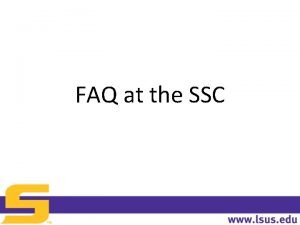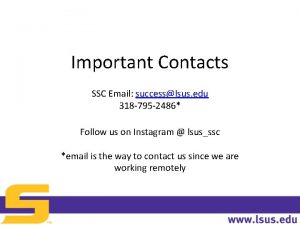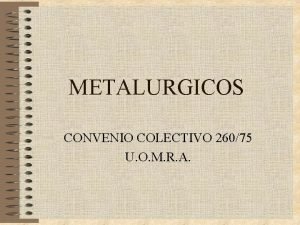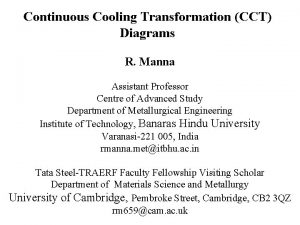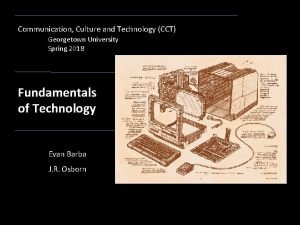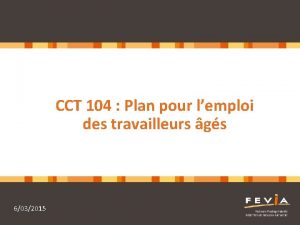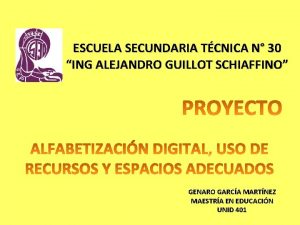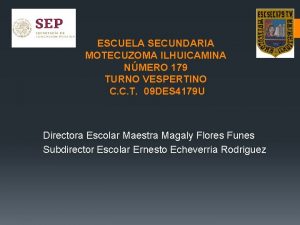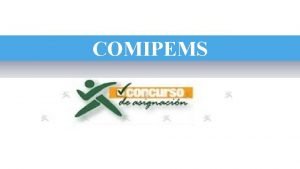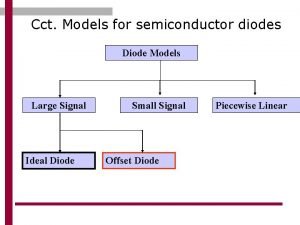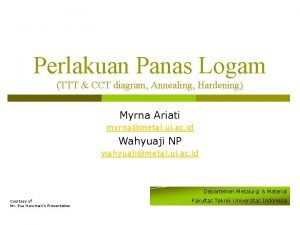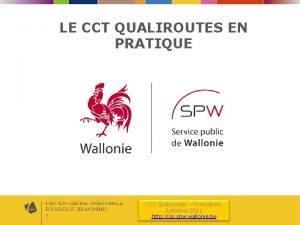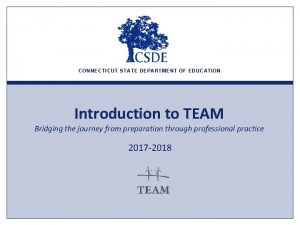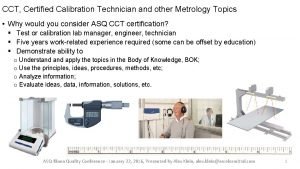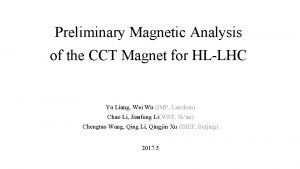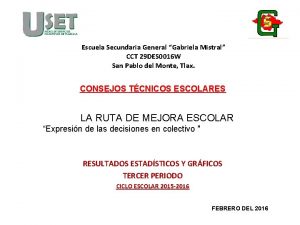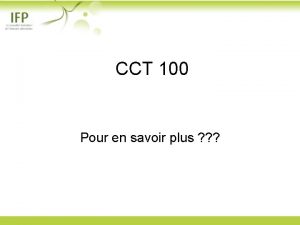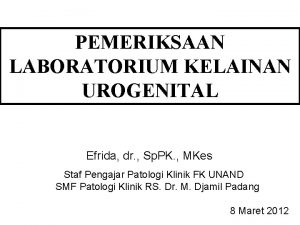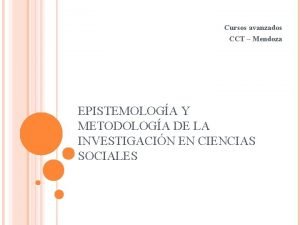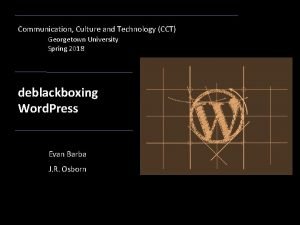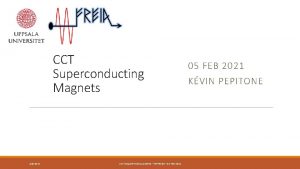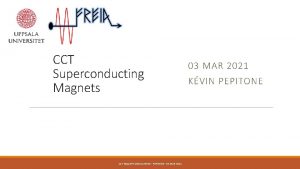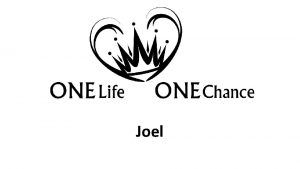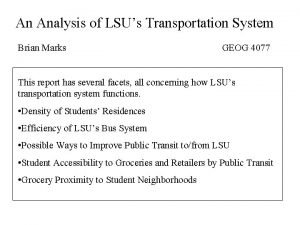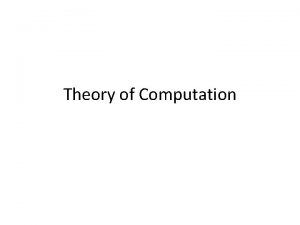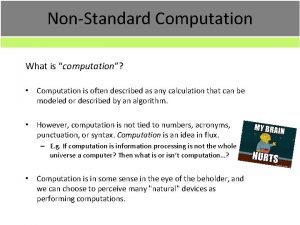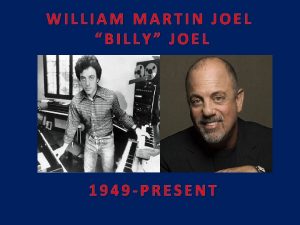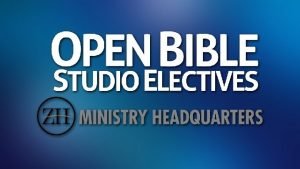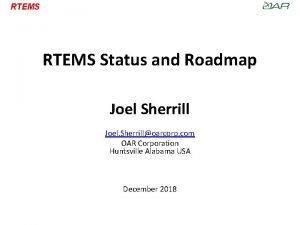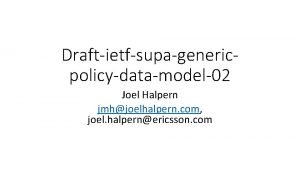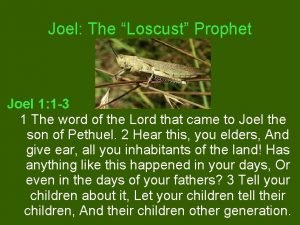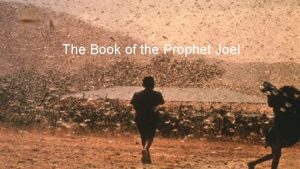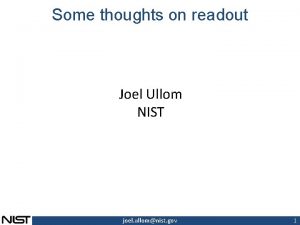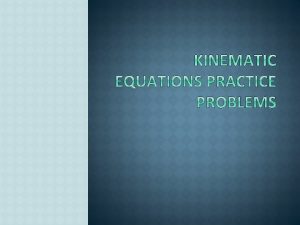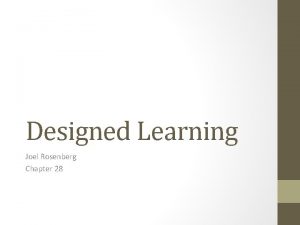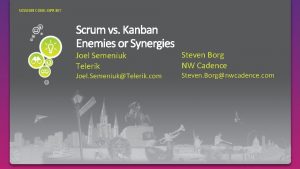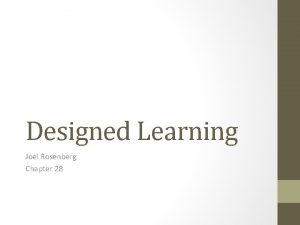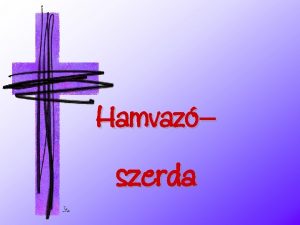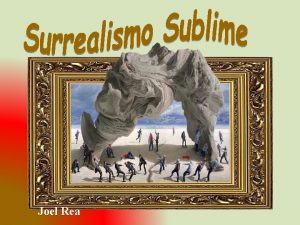LSUs Center for Computation Technology CCT Joel E





































- Slides: 37

LSU’s Center for Computation & Technology (CCT) Joel E. Tohline, Director 13 Dec. 2012 1

CCT is … An LSU research center whose mission, in part, is to infuse and enable computation – especially at the high end – into the forefront research and creative activities of all disciplines. • • • Faculty lines – currently, 26 (avg. 50/50 split appointments) across 11 departments and 6 colleges/schools; tenure resides in home department Cyber-Infrastructure – guide LSU’s (and state’s via LONI) cyber-infrastructure design to support research high-performance computing (HPC), networking, data storage/management, & to some extent, visualization; also associated HPC support staff Enablement staff – currently 12 senior research scientists (non-tenured; ideally, on soft money support) with HPC expertise who support a broad range of compute-intensive research projects Economic development – to date, most significant interactions have been with Louisiana’s burgeoning digital media industry (e. g. , video game design; visual effects) Education – Influence design and content of interdisciplinary curricula; for example: (1) computational sciences, (2) visualization, and (3) digital media 13 Dec. 2012 2

Brief Historical Perspective PART 1 13 Dec. 2012 3

Year: 2001 13 Dec. 2012 4

Year: 2001 13 Dec. 2012 5

Year: 2004 Governor Kathleen Blanco announces that the State is committing $40 million to the Louisiana Optical Network Initiative (LONI) over the next 10 years. 13 Dec. 2012 6

26 October 2011 7

26 October 2011 8

Faculty-Driven Research Activities PART 2 13 Dec. 2012 9

CCT Focus Areas Material World Coast-to-Cosmos System Sci. & Engineering Cultural Computing AVATAR Core Computation 13 Dec. 2012 10

CCT Focus Areas Office of Research & Economic Development Material World Coast-to-Cosmos System Sci. & Engineering Cultural Computing AVATAR Core Computation 13 Dec. 2012 11

CCT Focus Areas Office of Research & Economic Development Material World Coast-to-Cosmos System Sci. & Engineering Cultural Computing AVATAR Core Computation Academic Affairs Colleges Science Engineering Music & Dramatic Arts Mass Comm Business Civil PHYS PETE MATH ECE BIO CS 13 Dec. 2012 -----------Art & Design 12

CCT Focus Areas Material World Coast-to-Cosmos System Sci. & Engineering Cultural Computing AVATAR Core Computation Academic Affairs Colleges Science Engineering Music & Dramatic Arts Mass Comm Business Civil PHYS PETE MATH ECE BIO CS 13 Dec. 2012 -----------Art & Design 13

CCT Focus Areas Material World Coast-to-Cosmos System Sci. & Engineering Cultural Computing AVATAR Core Computation Academic Affairs Colleges Science Engineering Music & Dramatic Arts Mass Comm Business Civil PHYS PETE MATH ECE BIO CS 13 Dec. 2012 -----------Art & Design 14

Relevance to Biological Sciences (current & near term) • Faculty lines: – Michal Brylinski: 50/50 joint appointment w/ CCT; active involvement in “Material World” focus area; priority queue on Super. Mike II – CCT has committed to help with startup funds in connection with a “computational biology / microbial metagenomics” search that is underway in Biological Science (Brylinski is on search committee) 13 Dec. 2012 15

Cyber. Infrastructure PART 3 13 Dec. 2012 16

HPC in Louisiana Higher Education and 2002 : Super. Mike : ~ $3 M from LSU (CCT & ITS) 1024 cores; 3. 7 Tflops 11 th in Top 500 2006 : Tezpur : ~ $$ from LSU (CCT & ITS) 1440 cores; 15. 3 Tflops 2007 : Queen Bee : ~ $5 M thru Bo. R/LONI (Gov. Blanco) 23 rd in Top 500 5440 cores; 50. 7 Tflops; Became NSF-funded node on Tera. Grid 2012 : Super. Mike II : $2. 65 M from LSU (CCT & ITS) 7040 cores; 112 + 37. 5 Tflops 13 Dec. 2012 17

Super. Mike-II 13 Dec. 2012 18

Relevance to Biological Sciences (current & near term) • Cyber-Infrastructure: – Tezpur (LSU) and Queen Bee (LONI) available, free of charge to LSU researchers – Super. Mike II recently installed at LSU • • • 440 compute nodes: at 16 cores per node 7040 cores 50 nodes contain attached pair of GPUs to accelerate suitable codes 8 nodes are tied together via Scale. MP even serial codes can see 2 TBytes of RAM • In principle, able to execute Windows OS applications – Network infrastructure • Working closely with LSU’s ITS and LONI to build more steerable and higher bandwidth network connectivity across the campus and state that is smoothly integrated with national research networks – Data storage and management • 13 Dec. 2012 Working closely with LSU’s ITS and LONI to provide more adequate data storage and data management/ curation 19

Enablement Activities PART 4 13 Dec. 2012 20

Relevance to Biological Sciences (current & near term) • Enablement research activities – – – 13 Dec. 2012 Honggao Liu, CCT Deputy Director James Lupo, assistant director: Takes the lead in answering any computational research questions that arise in connection with the use of LSU/LONI’s high-performance computing infrastructure Jinghua Ge – visualization expertise; has supported campus visualization lab and has helped develop an Honors course heavily utilizing visualization tools across the sciences. Example, interaction with Professor Homberger’s research on anatomical kinematics of, e. g. , birds and cats Computational Biology & Bioinformatics Team: Currently 2 senior research scientists (Joohyun Kim and Nayong Kim) focused on assisting bioinformatics and broader computational biology efforts, especially in connection with LBRN = Louisiana Biomedical Research Network CCT search underway to hire a “Senior Bioinformatics Computational Scientist” 21

Cardinal Pose 13 Dec. 2012 22

CCT Computational Biology & Bioinformatics Team Joohyun Kim and Nayong Kim

13 Dec. 2012 24

Computational Biology/Bioinformatics Activities Software tools R/Bioconductor/Biopython Protein Gene Prediction : Glimmer, Gen. Mark. Hmm-p nc. RNA Gene Finding : Infernal, CMFinder, RNAz, Evofold Homology Sequence Match : exonerate, BLAST DNA motif Finding : MEME Comparative genomics : CGView, DAVID Functional genomics : GSEA, pathway analyses Microarray analysis : R/Bioconductor modules SNP : di. Bayes (Bioscope), BFAST, SAMTools, SOAPsnp CNV : (Bioscope) and others Small In. Del : (Bioscope), SAMTools and others Mapping : SSAHA 2, BFAST, BWA, SHRi. MP 2, Novoalign, Bowtie, MAQ, Stampy, SOAP 2 De Novo Assembly : EDENA, NGS Cell, ABy. SS, Velvet Misc (NGS Seq. Analysis): samtools, ARTEMIS, Bam. View Misc (others) : blast 2 GO, DAVID RNA-Seq : Top. Hat/Top. Hat-fusion, Cufflinks, Scripture, OASES, Trinity, and othes Ch. IP-Seq : MACS, and many Phylogeny : Mr. Bayes and others Molecular Dynamics : NAMD, CHARMM, Gromacs, LAMMPS, TINKER Visualization tools : VMD, IGV, Bam. View, Gbrowse • Genome Analysis Framework : Bioscope, GATK, and GALALXY, Cloud. Burst, Cloud. Blast, Crossbow, … * DARE-NGS - DARE (Dynamic Application Runtime Environment)-based Science Gateway

Next-Generation Seq. Data Bioinformatics Infrastructure DNA Seq. Center Ion Torrent System B : Visualization Server Cloud computing System A : Computation NAS - Located at Frey Building Bioport v Four-tier Infrastructure v Modular architecture v Integrated service (compute/data) v Scalable & Extensible by DARENGS IT Storage (1 TB : $1 K/yr) Remote Users LONI (project space)

DARE Framework DARE provides abstractions to developers of science gateways. These abstractions allow developers and scientists to focus on the unique requirements of their scientific applications and relevant workflows as opposed to focus on the “plumbing” of how to submit ensembles of simulations to several supercomputers concurrently and archive their results. DARE is the natural evolution of science gateway middleware. As resource platforms, network capabilities and data repositories grow in size, number and vary in interface, the emergence of a unifying framework was inevitable. Many of the critical features of the DARE framework are provided by SAGA and the Pilot-Job capability: SAGA-Big. Job SAGA demonstrated the capability (and usefulness) of overcoming utilization issues associated with distributed compute and data resources, complex multi-level workflows and run-time decision making. Building a science gateway framework on top of SAGA was the next logical step. The DARE framework’s distinguishing features include support for HPDC infrastructure and application/application workflow agnosticism.

DARE Framework Available Services – three different types Service Type III Service Description Standalone Single Tool Pipeline Tool Dynamic Workflowbased Tool Example Target Application Mapping Ch. IP-Seq, RNA-Seq Bfast, BWA, Bowtie, ABy. SS Mapping+MACS, Top. Hat-Fusion, Trans -ABy. SS, Hydra, GATK N/A Example of Existing Tools Upcoming Services RNA-Seq pipelines Structural Bioinformatics : e. Thread

DARE-NGS Scale out performance for DNA sequence mapping using BFAST on HPC Scale out performance for DNA sequence mapping using BWA with Map-Reduce

Relevance to Biological Sciences (current & near term) • Enablement research activities – – – 13 Dec. 2012 Honggao Liu, CCT Deputy Director James Lupo, assistant director: Takes the lead in answering any computational research questions that arise in connection with the use of LSU/LONI’s high-performance computing infrastructure Jinghua Ge – visualization expertise; has supported campus visualization lab and has helped develop an Honors course heavily utilizing visualization tools across the sciences. Example, interaction with Professor Homberger’s research on anatomical kinematics of, e. g. , birds and cats Computational Biology & Bioinformatics Team: Currently 2 senior research scientists (Joohyun Kim and Nayong Kim) focused on assisting bioinformatics and broader computational biology efforts, especially in connection with LBRN = Louisiana Biomedical Research Network CCT search underway to hire a “Senior Bioinformatics Computational Scientist” 30

Relevance to Biological Sciences (current & near term) • Enablement research activities – – – 13 Dec. 2012 Honggao Liu, CCT Deputy Director James Lupo, assistant director: Takes the lead in answering any computational research questions that arise in connection with the use of LSU/LONI’s high-performance computing infrastructure Jinghua Ge – visualization expertise; has supported campus visualization lab and has helped develop an Honors course heavily utilizing visualization tools across the sciences. Example, interaction with Professor Homberger’s research on anatomical kinematics of, e. g. , birds and cats Computational Biology & Bioinformatics Team: Currently 2 senior research scientists (Joohyun Kim and Nayong Kim) focused on assisting bioinformatics and broader computational biology efforts, especially in connection with LBRN = Louisiana Biomedical Research Network CCT search underway to hire a “Senior Bioinformatics Computational Scientist” 31

Visiting Panelists (February 2012) 13 Dec. 2012 32

Strengthening Bioinformatics Research at PBRC and LSU Expert Panel Recommendations 15 -17 February 2012 13 Dec. 2012 33

Strengthening Bioinformatics Research at PBRC and LSU Expert Panel Recommendations 15 -17 February 2012 13 Dec. 2012 34

Bioinformatics Hire Search Committee • • Brown, Jeremy (Biological Sciences) Canavier, Carmen (LSUHSC Biology & Anatomy) Kim, Joo (Biological Sciences) Macaluso, Kevin (SVM’s Pathobiological Sciences) Monroe, Todd (Biological & Agricultural Engineering) – committee chair Mores, Chris (SVM’s Pathobiological Sciences) Salbaum, Michael (Pennington Biomedical Research Center) Ullmer, Brygg (CCT and Computer Science) 13 Dec. 2012 35

Senior Bioinformatics Computational Scientist (draft advertisement) • The Center for Computation & Technology (CCT) at Louisiana State University invites applications for a senior research scientist position in Computational Bioinformatics, broadly defined. The successful candidate will recruit and lead an Interdisciplinary Research Support Group (IRSG) that will support and integrate dataintensive and computationally demanding research activities across various academic units on LSU’s main campus, at the LSU School of Veterinary Medicine, the Pennington Biomedical Research Center, and LSU’s Health Sciences Centers. The IRSG will support research in genomics, bioinformatics, biostatistics, biomolecular structure/function, systems biology modeling, computational neuroscience, and other areas. • The new leader of the IRSG will be charged with mobilizing this infrastructure to support the cutting-edge, interdisciplinary research activities described above. S/he will participate in and lead the development of extramural grant proposals. Equally important, s/he will develop programs to assist faculty and scientists in their use of bioinformatics and computational resources -- by individual mentoring and by workshops and tutorials. The IRSG leader will be encouraged to develop collaborative ties with industrial scientists across Louisiana. • Required Qualifications: Ph. D. in biology, computational science, or a related area with emphasis on bioinformatics data analysis; five years of experience. • Additional Qualifications Desired: Experience leading bioinformatics and biostatistics projects, teams and software use and development. Experience with common software development languages and tools, software design, and architecture and with the scripting tools commonly used by bioinformaticists: PERL, GALAXY, R/Bioconductor, etc. Experience with large dataset management specific to next-generation sequencing. Experience in the development of web interfaces to bioinformatics tools. Experience with high-performance computing, parallel programming and/or programming frameworks. Experience using virtual collaborative environments. • Appointment and salary will be commensurate with experience and qualifications. This is a non-tenure track research position. 13 Dec. 2012 36

THANK YOU 13 Dec. 2012 37
 Si chen lsus
Si chen lsus Nancy albers lsus
Nancy albers lsus Qualiroute
Qualiroute Cct 260/75
Cct 260/75 Cct qualiroutes
Cct qualiroutes Slope change in a cct diagram signify
Slope change in a cct diagram signify Consumer culture theory (cct): twenty years of research
Consumer culture theory (cct): twenty years of research Cct georgetown
Cct georgetown Cct 104
Cct 104 Ing alejandro guillot schiaffino biografia
Ing alejandro guillot schiaffino biografia Motecuzoma ilhuicamina 179
Motecuzoma ilhuicamina 179 Secundaria 214 carlos marx
Secundaria 214 carlos marx Cct model
Cct model Diagram cct dan ttt
Diagram cct dan ttt Cct qualiroutes
Cct qualiroutes Victor hugo secundaria
Victor hugo secundaria Team dashboard ct
Team dashboard ct Qualiroutes
Qualiroutes Calibration technician training
Calibration technician training Cct
Cct Cartelera de cuentos
Cartelera de cuentos Cct 29
Cct 29 Cct 100
Cct 100 Rumus klirens kreatinin
Rumus klirens kreatinin Cct mendoza cursos
Cct mendoza cursos Communication culture and technology
Communication culture and technology Kontinuitetshantering i praktiken
Kontinuitetshantering i praktiken Novell typiska drag
Novell typiska drag Tack för att ni lyssnade bild
Tack för att ni lyssnade bild Ekologiskt fotavtryck
Ekologiskt fotavtryck Varför kallas perioden 1918-1939 för mellankrigstiden
Varför kallas perioden 1918-1939 för mellankrigstiden En lathund för arbete med kontinuitetshantering
En lathund för arbete med kontinuitetshantering Särskild löneskatt för pensionskostnader
Särskild löneskatt för pensionskostnader Personlig tidbok för yrkesförare
Personlig tidbok för yrkesförare Anatomi organ reproduksi
Anatomi organ reproduksi Vad är densitet
Vad är densitet Datorkunskap för nybörjare
Datorkunskap för nybörjare Stig kerman
Stig kerman
